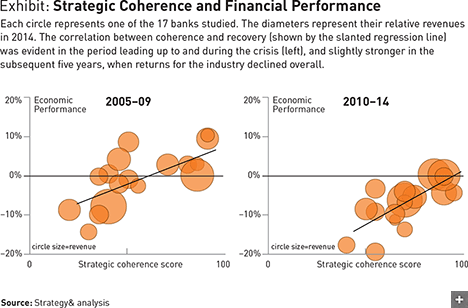(By Alan Gemes and Joerg Reutschi)
Why coherent institutions were the first to rebound after the financial crisis.
The conventional wisdom within the banking industry about its troubles since the recent global financial crisis goes something like this: Rightly or wrongly, regulators imposed new rules that forced banks, particularly in the U.S. and Europe, to adopt new, less risky (and less rewarding) business strategies. The challenges of enforced constraint were exacerbated by macroeconomic developments, lack of customer trust, new digital technologies, and upstart financial technology–oriented competition — in other words, by external factors the banks had little ability to influence.
But the most critical factor constraining banks after the financial crisis was not external at all. It was the banks’ own strategy. When they took steps to become coherent, they began to recover and thrive.
A study conducted by Strategy&, PwC’s strategy consulting group, analyzed banking performance during and after the financial crisis. We found a strong correlation between strategic coherence, performance, and recovery. (Coherence, in this context, means the degree of alignment among a company’s strategy, its capabilities, and the portfolio of products and services it offers.) Among the 17 large banks that we studied, all based in Europe or North America with operations around the world, the most coherent in 2007 were the most stable performers throughout the seven years that followed. As for the rest, those that moved decisively after the crisis to become more coherent saw the greatest performance improvement. Other banks — those that took either tentative steps or none at all — took longer to recover.
In studies of coherence in business — such as Strategy That Works, by Paul Leinwand and Cesare Mainardi (Harvard Business Review Press, 2016) — it’s rare to hear financial-services companies mentioned. So we set out to explore whether coherence could make a difference in banking. The answer appears to be a resounding yes.
We knew that incoherence had been rampant in the sector during the years leading up to the financial crisis. Many banks had moved aggressively into new high-growth lines of business such as investment banking and the trading of complex financial products. Our hypothesis was that in some cases, firms pushed into these growth areas too rapidly and indiscriminately. They got caught up in a classic growth treadmill: chasing multiple market opportunities without the capabilities needed to win. A few large banks had been more coherent than the rest. How strong was the link between coherence and financial performance?
To answer that question, we looked at the 50 largest banks in the world as measured by revenue, thus drawing from a group of comparable and relatively influential companies. We narrowed the list to banks based in Europe and North America, because they were more affected by the financial crisis than banks based in Asia or Australia. Of the remaining 30 banks, we selected a sample of about half — 17 banks in all, spread out geographically but otherwise chosen at random. We scored them on performance using a publicly available metric: return on equity, minus the cost of capital. Factoring in the cost of capital was important, as banks with more risky business lines and expectations of higher returns (for example, global markets with trading profits) consume more capital than conservative banks with less volatile returns, such as private banking and wealth management firms with fee-based profits.
Coherence and Recovery
Once we had chosen the institutions to study, we were left with the challenge of measuring coherence. No single metric can capture alignment among different facets of an organization. We analyzed four attributes that shed light on each bank’s level of coherence. (1) How well did its portfolio of businesses fit together and build on the same capabilities? (2) How clearly was the identity of the bank expressed through a single value proposition understood by its stakeholders? (3) How well-suited was its geographic scope to its strategy — that is, did it expand only into territories where it had a good chance of succeeding? (4) How successful was its merger and acquisition activity in buying firms where it could either leverage its own existing capabilities or sustainably apply the capabilities of the businesses it acquired?
Questions like these can be answered only by consensus judgment. Thus, we assembled a panel of Strategy& and PwC industry experts and a collection of investor presentations and analyst reports about each bank to augment the panel’s knowledge. Following a rigorous set of evaluation criteria, we scored each of these four factors on a scale of one to 25. We then calculated a coherence score for each bank, based on the combined 100-point scale, for two periods: the years leading up to the crisis and into the worst of it (2005–09) and the aftermath (2010–14). We compared our coherence scores to the financial results for the same time period (see exhibit).
It turned out that the banks in our sample had responded to the crisis in four different ways, with significant performance implications. The four groups are detailed here.
• Consistent and coherent. The banks in this group, six of the 17 we studied, were coherent before the crisis and remained so. As our hypothesis had suggested, they performed well, even at the height of the turbulence. Some tweaked their strategy in reaction to the crisis, for example, by changing their funding sources. But they didn’t have to change much, and they had the strongest overall financial results. Indeed, many were stronger in 2014 than they had been in 2007. Some took advantage of their competitors’ decline by acquiring businesses (at a relatively low cost) that bolstered their own strategies. Today, these banks continue to invest in distinctive capabilities — such as technologically sophisticated back-office operations and online banking — that further strengthen their positions.
• Strategic change toward coherence. The four banks in this group did not have a high level of coherence before the crisis. They had pursued lofty ambitions, trying to build themselves into global powerhouses in some cases by expanding into businesses where they had little expertise. They suffered accordingly in the 2007–09 period, incurring losses and, in some cases, accepting government bailouts. But between 2009 and 2012 each of them radically restructured to become more coherent, even when this meant significantly scaling back or exiting geographies, major lines of business, or both. These decisive moves paid off. The financial performance of each bank showed marked improvement within 18 months of making the shift.
• Incremental strategic change. The five banks in this group were also relatively incoherent when the financial crisis started, and their financials dropped dramatically. But they made only incremental changes to their strategies, tinkering at the margins. They soon found themselves with lines of business that underperformed. These banks gradually reshaped their strategies, and their performance has begun to recover since 2015.
• Delayed strategic change. The final category contained just two banks. When the crisis started, they did not exhibit much coherence. But they also didn’t face a capital crunch and did not need government help to survive. This apparently made them confident, and they stuck to their strategies for expansion. After the crisis, their performance declined slowly but consistently until they entered the ranks of the poorest performers. It’s noteworthy that since 2014 (the last year of data that we studied), both have taken on new leadership and are beginning to implement a coherence-oriented strategy.
Moving Forward
Every bank we studied, in all four groups, had at least begun to recover from the financial crisis by 2014. But recovery was much easier for some banks than others. That finding has significant implications for banks in today’s rapidly changing marketplace.
Every bank we studied has begun to recover from the financial crisis of 2007–09. But recovery was much easier for some than others.
A top priority for many banks now is regaining their relevance and reputation by rebuilding customer trust, demonstrating a positive role as facilitators of economic activity and prosperity. They have to demonstrate not just the will but the coherence needed to deliver.
To find the funds for investment in their new, more strategic priorities, for example, banks may have to eliminate marginally profitable lines of business, overhaul incentive plans, redesign processes to harness digital technology, and rethink their outsourcing approaches. They will have to reinvest in new capabilities, including digital and financial technology (fintech) prowess. They also need to revitalize their recruiting and retention practices. In the 2000s, much of the best talent coming out of business schools went into investment banking. Now, the best people go elsewhere, often to technology companies. Banks need to win those employees back.
Most of all, each bank needs to develop a clear identity based not on what it sells but on what it does best. This will take nuanced, deliberate thinking. For example, many global banks are paring back investment banking activities and focusing on wealth management. But being in wealth management won’t be enough to guarantee success in such a crowded market.
Start by asking how your company can create the most value. Will yours be the bank that innovates? That puts the customer first? That pursues the digitization of banking, both at the customer interface and in your core processes? Or that parlays capital into high-leverage investments? Then consider your ability to deliver. Do you have the necessary capabilities? If you don’t have them now, are you equipped to build or buy them? Do you have a blueprint for bringing them to life? Are your stakeholders, internal and external, committed to working with you?
The strongest banks will shape the future of the industry. Instead of trading their way to the top, they will attract customers by meeting their needs and interests. That will take a level of coherence that the financial-services industry has not seen for many years. Our study suggests that it is now beginning to reemerge.
Author Profiles:
- Alan Gemes is an advisor to boards and executives in the financial-services industry for Strategy&, PwC’s strategy consulting business. Based in London, he is a partner with PwC UK. He serves leading banks throughout Europe and Asia.
- Joerg Ruetschi is a specialist in the strategic and structural transformation of banking and capital market businesses for Strategy&. He is a director with PwC UK, based in London.
- Also contributing to the analysis underlying this article were Vidhi Gupta and Alex Harriss, both of PwC UK and active with Strategy&.
The article originally appeard on: www.strategy-business.com























